Transportation's Environmental Impact: Regulations Drive Cleaner Tech
Transportation, from cars to planes, significantly impacts our environment. Each mode has unique consequences, with air quality being a major concern due to emissions from fossil fuel-powered vehicles. Regulations worldwide aim to reduce these emissions and promote sustainability.
Air travel, maritime shipping, and road vehicles, particularly those relying on fossil fuels, release pollutants like nitrogen oxides and particulate matter, contributing to climate change. Regulations, from local to international levels, target these emissions. Innovations like electric vehicles and alternative fuels help reduce these impacts.
Historically, transportation laws focused on economic growth and mobility. However, as environmental awareness grew, so did provisions to minimize impact. For instance, Europe's Zero-Emission Zones and strict CO2 reduction targets for new cars and transporters are leading the way in reducing road traffic emissions.
Transportation's environmental impact is multifaceted, including air pollution, greenhouse gas emissions, noise pollution, and habitat disruption. A comprehensive legal framework is crucial to guide cleaner technologies and practices, ensuring sustainable transportation for the future.







